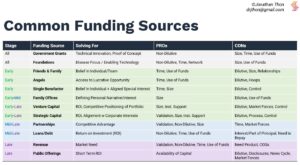Financing in a Challenging Environment
Jonathan Thon, Ph.D. • June 1, 2023
Given the current financing landscape, there is a need to get more creative and think more broadly when funding a biotech company. As highlighted in an excellent overview by Bruce Booth in his Life Sci VC blog, aggregate venture capital funding in 2023 is well off the peak from recent years. The domino effect of this has resulted in shutdowns, restructurings, and lay-offs across the industry.
I recently participated in a panel session hosted by Bayer on alternative funding models for the biotech industry. During the event, I shared my perspective on the expectations from various funding sources, the pros and cons of each, and what brings long-term value when navigating development and building a biotech company. In this blog post, I share some thoughts on these important and timely topics.
Build a Syndicate
There are many sources of funding from government grants to angel investors, venture capital, venture debt, partnerships, and ultimately, public offerings and revenue (Table 1). It is important to consider these options with a stage-centric lens – that is, what are these various groups solving for and what is the biotech company solving for at this stage of growth. It is essential to build a syndicate of funding sources that can complement one another and support the vision of the company into the next stage of development.
Table 1.

While there are pros and cons related to each type of funding, these should be considered in a general sense. Every individual fund is the exception to the rule. As such, it’s very important to engage with the specific investment source and understand them, what they are looking for, and how they operate. These factors contribute to the ability to construct a syndicate with individual funding sources that generally wouldn’t be expected; rather, the specific nuances of those individuals make it possible.
Get to “I Do” and Staying Together
At the end of the day, these are long-term marriages as you’ll be with these partners for a long time. In all honesty, sometimes you’re trying to just get a financing done. But it’s a bad idea to force a relationship that doesn’t look like it’s going to work; any friction is only going to compound, and it will make things difficult or impossible thereafter. Don’t force it.
“Before you marry a person, you should first make them use a computer with slow internet to see who they really are.” — Will Ferrell
Be mindful that the first meeting with a funding source is really just an introductory meeting. This step is intended to share the big picture and understand how the fund works, how it’s organized and operated, what capital it has to deploy, and the expectations. This is the time to make sure that there is alignment with what the company is, what it’s building for, how it expects to develop, and how it plans to leverage investors’ capital. You’re solving for the second date, where you can share more details about what makes each other special and kick the tires on some of the places where alignment may be unclear.
If there isn’t an immediate fit, consider parking that conversation for a period of time, recognizing that funds evolve, partners change, and the timing might just be wrong. Just because the fit is not there today, it can be there tomorrow, and you should keep each other updated and reconnect when there may be more traction. Redirect present efforts to the places where there is better alignment.
If the engagement moves forward, the culmination of the diligence process on both sides will lead to recognition whether this is something worth taking a shot at together.
Share a Problem-Solving Narrative
When engaging with funding sources it is essential to clearly communicate the unmet need, key points of differentiation, and supporting data.
At STRM.BIO, we talk with potential investors about the huge unmet need in the gene therapy industry – the inability to deliver these therapeutics to their intended target in the body.
One aspect of our approach that has been particularly appealing to investors is the translation of biodistribution and repeat dosing/tolerability findings in smaller animals to larger animal models. It is apparent that many companies developing next generation delivery platforms are hitting a technical snag at this point that they are struggling to overcome. This is obvious in investor conversations where we keep hearing the same question asked: will the platform translate to non-human primates – in our case the answer is yes. We have a solution to the problem that stands to bridge this next generation of in vivo gene therapies. We recently showed this in vivo, and together with our investors unlocked an opportunity that others have not been able to advance in gene therapy. What is possible suddenly became tangible.
Lean Into Your Competitive Advantage
Our partners are solving for making gene therapies available to a much larger range of patient populations. They’ve watched gene therapy programs struggle with delivery challenges and are excited not just by our gene therapy programs, but the underlying platform technology that can be applied to portfolio companies and partnered to advance clinical programs that are otherwise not moving forward. Our competitive advantage is the potential to deliver the next generations of cell and gene therapies and bring new treatments to market by making gene therapies a viable option for people.
Without a doubt, it has been a challenging environment for financing. In these conditions, it is even more important to apply some tried and true best practices of fundraising which include understanding what potential investors are solving for, building a syndicate for the long-term, and presenting a compelling narrative, backed with data, about how you are uniquely positioned to address an unmet need. And trust that you are in good company.
“To give somebody your time is the biggest gift you can give.” — Franka Potente